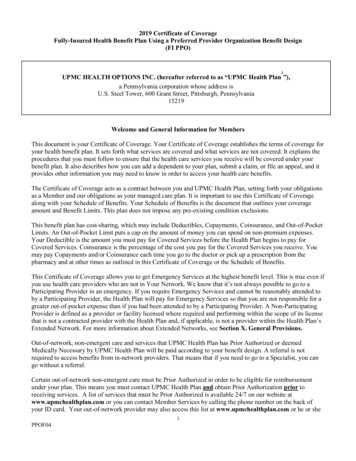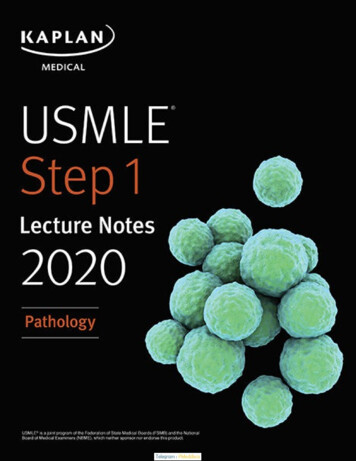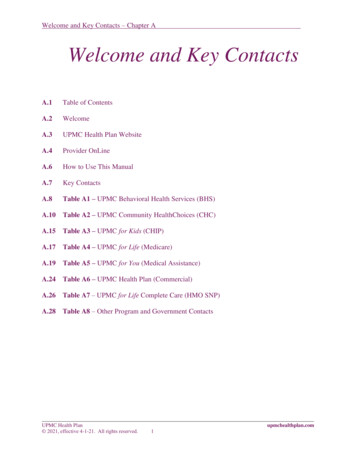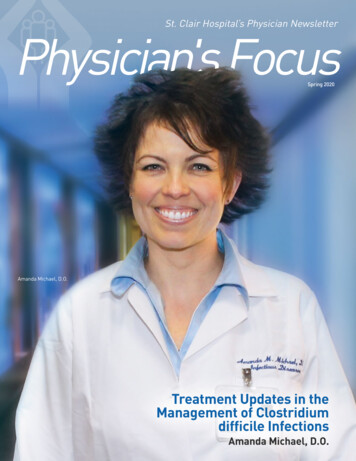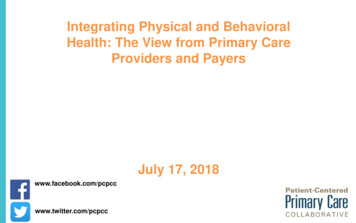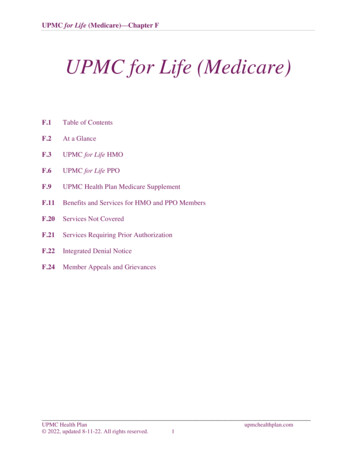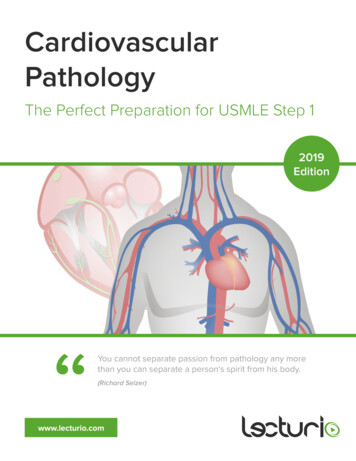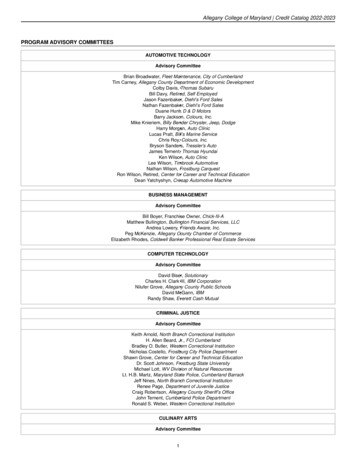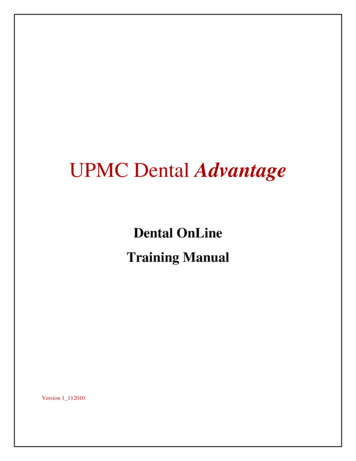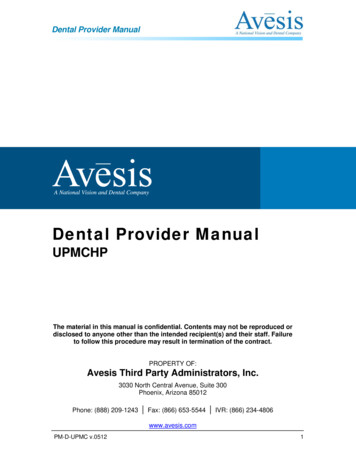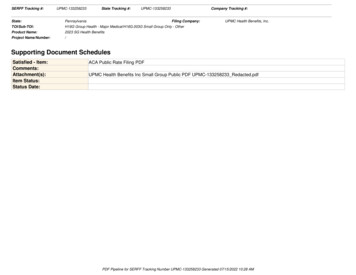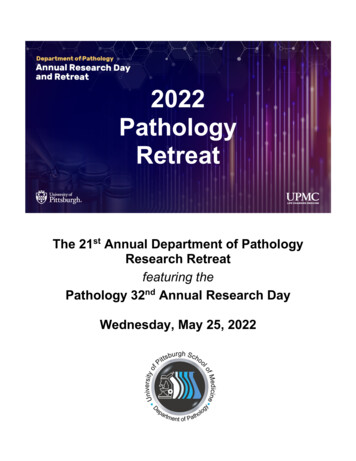
Transcription
2022PathologyRetreatThe 21st Annual Department of PathologyResearch Retreatfeaturing thePathology 32nd Annual Research DayWednesday, May 25, 2022
Program ContentsResearch Day Agenda . page 3Poster Session & Abstracts . page 5Trainee Awards . page 78Poster Winners, 2021 Pathology Retreat . page 79Retreat Planning CommitteeFacultyAndrew Duncan, PhD, ChairSameer Agnihotri, PhDAaron Bell, PhDCharleen Chu, MD PhDMarie DeFrances, MD PhDRoy Frye, MDWendy Mars, PhDOctavia Palmer, PhDAlex Soto, MD PhDJian Yu, PhDGraduate StudentsRithika BeheraJoud MullaCoordinatorsShanning WanAmanda Bytzura, MBA
2022 Pathology RetreatKeynote PresentationKeynote Presentation12:00 – 1:00 pmPilar Alcaide, PhDAssociate Professor of ImmunologyTufts University School of MedicineFaculty & Trainee Presentations1:30 pmOpening RemarksAndrew Duncan, PhDAssociate Professor of Pathology May 25, 2022Location: S120 BST & https://pitt.zoom.us/j/96992431085T Cell Immune Responses in Heart Failure: An InterplayBetween Cardiac Inflammation and FibrosisLocation: S120 BST & https://pitt.zoom.us/j/96992431085George Michalopoulos, MD, PhDMaud L. Menten Professor and Chair of PathologySession 1: Graduate Student ResearchModerator, Joud Mulla, BS1:35 – 1:55 pmJeremy Rich, MD, MHS, MBAProfessor of NeurologyKilling Brain Tumor Stem Cells1:55 – 2:05 pmRaphael Crum, BSPhD Candidate, CMP, MSTPMatrix Bound Nanovesicles as a Novel Extracellular MatrixTherapy for the Treatment of Rheumatoid Arthritis2:05 – 2:15 pmDaniel Zuppo, BSPhD Candidate, MGDB, CATERfoxm1 is Required for Cardiomyocyte Proliferation After AdultZebrafish Cardiac Injury2:15 – 2:25 pmTaylor Gatesman, BSPhD Candidate, CMPInhibiting Insulin Signaling Reverses Resistance to PI3K-MtorInhibitors in Aggressive Pediatric High-Grade GliomasSession 2: Basic ResearchModerator, Justin Sui, BA2:30 – 2:50 pmMo Ebrahimhkani, MDAssociate Professor of PathologyStem Cell-based Multicellular Systems: New Platforms forRegenerative Technologies and to Study Human Development2:50 – 3:00 pmKatherine Killian, DOPathology ResidentThe Receptor for Advanced Glycation Endproducts PromotesAllergen Driven Neutrophil Dominant Airway Inflammation ViaNLRP3 Inflammasome Activation3:00 – 3:10 pmMichelle Drewry, BSPhD Candidate, BioE, CATERScaffold-Free Conduits Formed from Dental Pulp Stem CellSheets Provide Neurotrophic and Directional Support forRegenerating Axons3:10 – 3:20 pmSowmya Mekala, PhDPostdoctoral FellowAntagonizing Activin A/P15ink4b-Signaling as a TherapeuticStrategy for Liver Disease
Session 3: Clinical ResearchModerator, Simmi Patel, MD3:30 – 3:50 pmSarah Wheeler, PhD, FACB, CCAssistant Professor of PathologyData Driven Improvement for Diagnostic Testing in SpecialPopulations3:50 – 4:00 pmAzfar Neyaz, MDPathology ResidentLoss of PTEN and Expression of GLUT1 Predict theMetastatic Progression of Pancreatic Neuroendocrine Tumors4:00 – 4:10 pmShikha Malhotra, MDPathology ResidentPersistent NUP98 Rearrangement may Portend PoorPrognosis4:10 – 4:20 pmAkram Shalaby, MDGI Pathology Clinical InstructorGastric Intestinal Metaplasia as a Risk Factor for Progressionto Gastric Dysplasia and Carcinoma in Patients Who UndergoGastric Biopsy: a Population-Based StudyPoster Session & Reception5:00 – 7:00 pmUniversity Club, Ballroom BBack in person! Join your colleagues at the Pitt University Club for an interactive poster session,hors d'oeuvres, and drinks. Say hello to old friends and make some new ones.NotesParticipation by all individuals is encouraged. Advance notification of any special needs will help us provide better service. Please notifyus of your needs at least two weeks in advance of the program by emailing Shanning Wan at shw126@pitt.edu.All individuals in a position to control the content of this education activity are required to disclose all relevant financial relationships withany entity producing, marketing, re-selling, or distributing health care goods or services, used on, or consumed by, patients.Keynote Speaker Presentation: This activity is approved for AMA PRA Category 1 Credit . Sponsored by The Department ofPathology in conjunction with the Cellular and Molecular Pathology Graduate Program and University of Pittsburgh School of MedicineCenter for Continuing Education in the Health Sciences. The University of Pittsburgh School of Medicine is accredited by theAccreditation Council for Continuing Medical Education to provide continuing medical education for physicians. The University ofPittsburgh School of Medicine designates this live activity for a maximum of 1.0 AMA PRA Category 1 Credits . Physicians shouldclaim only the credit commensurate with the extent of their participation in the activity. Other health care professionals are awarded 0.1continuing education units (CEU’s) which are equal to 1.0 contact hours.The University of Pittsburgh is an affirmative action, equal opportunity institution.
2022Poster Session& AbstractsMay 25, 2022, 5:00 – 7:00 pmBallroom B, University ClubUniversity of PittsburghPresentation Schedule5:00 – 6:00 pmOdd-numbered posters6:00 – 7:00 pmEven-numbered posters
Graduate, Basic Research1.Anu Balogun, Beta-catenin inhibition as a noveltherapeutic strategy for porphyria21. Jie Bin Liu, Characterizing and Targeting ERBB2Mutations in Invasive Lobular Carcinoma2.Maria Beecher, MALT1 as a mediator of treatmentresistance in triple-negative breast cancer3.Rithika Behera, Transcriptional regulation of SScdermal myofibroblasts by FOSL2 and FOXP122. Joseph Maggiore, Human kidney organoidsdemonstrate HDAC8 as a therapeutic target to attenuateEMT in kidney disease4.Hannah Butterfield, Evaluating small extracellularvesicles as immunomodulatory components of themicroenvironment in p95HER2 breast cancer5.Julianna Castle, The Impact of Profilin-1 Mutations onProtein Homeostasis in Amyotrophic Lateral Sclerosis6.Margaret Champion, Investigating the role of alternativesplicing in reproductive aging and maternal-fetal health7.Mona Chatrizeh, Microbiome targeted nutrition tosupport lymphopoiesis during critical illness8.Grace Conway, Development of an in vitro System toUnderstand the Mechanisms of Ultrasound-TargetedMicrobubble Cavitation-Mediated Blood Brain BarrierOpening9.Raphael Crum, Matrix Bound Nanovesicles as A NovelExtracellular Matrix Therapy For The Treatment OfRheumatoid Arthritis10. Andrea Cruz, The Role of Tumor MicroenvironmentDerived Growth Factors in Pediatric Brain Tumors11. Michelle Drewry, Scaffold-free conduits formed fromdental pulp stem cell sheets provide neurotrophic anddirectional support for regenerating axons12. Taylor Gatesman, Inhibiting insulin signaling reversesresistance to PI3K-mTOR inhibitors in aggressivepediatric high-grade gliomas13. Shohini Ghosh-Choudhary, Whole Genome CRISPRScreen Reveals Vulnerabilities of Senescent Cells14. Matthew Halbert, Loss of MAT2A CompromisesMethionine Metabolism and Represents a Vulnerabilityin H3K27M Mutant Glioma by Modulating theEpigenome15. Shea Heilman, Uncovering Differentiation-InhibitoryMechanisms in the Developing tet2-/-;tet3-/- ZebrafishRetina16. Richard Herron, Identification of a direct role of CPSF6and a key cis-acting motif in promoting TRIM9 proximalpolyA site usage17. Joshua Hislop, Synthetic Morphogenesis of HumanBlastocyst-to-Gastrula Bilaminar Disc18. Yekaterina Krutsenko, Investigating the therapeuticefficacy of a novel mTORC1 inhibitor, RMC-6272, onliver tumors with b-catenin activation19. Ryan LeGraw, Understanding and Engineering HumanHematopoiesis using a Genetically Engineered FetalLiver Niche20. Mingjun Liu, H3K4me2 regulates perivascular cellparticipation in microvascular remodeling in mousehindlimb ischemia model23. Meagan Makarczyk, Joint Pain on a Chip: MechanisticAnalysis, Therapeutic Targets, and an EmpiricalStrategy for Personalized Pain Management24. Philip Mannes, In vivo molecular imaging of chemokinelike receptor 1 (CMKLR1) in experimental lung injury25. Nicole Martucci, Inhibition of Phosphoinositide 3-kinasedelta (PIK3CD) Suppresses Hepatocyte Proliferation byMore than 50% in the Regenerating Liver after PartialHepatectomy26. Meghan Mooring, CYR61 orchestrates NASH fibrosisthrough IRAK4-SYK-NFκB-PDGF signaling in monocytederived macrophages27. Joud Mulla, The Role of Caspase-11 in TraumaInduced Coagulopathy (TIC) in a Murine PolytraumaModel28. Alexis Nolfi, Therapeutic Use of an Interleukin-4 EyeDrop in a Rabbit Model of Dry Eye Disease: A PilotStudy29. Matthew Poskus, Overcoming Stroma-Mediated DrugResistance in HER2 Breast Cancer30. Tamandeep Saggi, Hindlimb Muscle Representations inMouse Motor Cortex Defined by Viral Tracing31. Justin Sui, Temporal Assessment of Single-Cell RNASequencing in a Mouse COPD Model Identifies AberrantMacrophage Inflammatory and Metabolic FunctionsDependent on Adenine Nucleotide Translocase 1 (ant1)32. William Tennant, Phosphorylation state of TDP-43alters both liquid-liquid phase separation andnuclear/cytoplasmic localization33. Rick van der Geest, BATF2 mediates pro-inflammatorycytokine production in alveolar macrophages andenhances the early host defense against pulmonaryKlebsiella pneumoniae infection34. Jeremy Velazquez, Directing morphogenesis of humanliver organoids in vitro via engineering inter- and intracellular regulatory networks35. Susannah Waxman, Multicolor DiOlistic LabelingReveals Astrocyte Morphology in the CollagenousLamina Cribrosa36. Sierra Wilson, Diploid Hepatocytes ResistAcetaminophen-induced Acute Liver Injury and DriveCompensatory Regeneration37. Jiazhen Xu, The study of Circular RNAs and theirregulation of TAR DNA binding protein 43 (TDP-43)pathological aggregation38. Daniel Zuppo, foxm1 is required for cardiomyocyteproliferation after adult zebrafish cardiac injury
Post-Graduate, Basic Research39. Chhavi Goel, β-catenin Overexpressing HepatocytesReduce Bile Stasis by Contributing to CholangiocyteLike Phenotype in Murine Model of IntrahepaticCholestasis40. Katherine Killian, The receptor for advanced glycationendproducts promotes allergen driven neutrophildominant airway inflammation via NLRP3 inflammasomeactivation41. Quitterie Larrouture, Osteoblast form an epithelial-likelayer which play an important role in ion transport42. Sowmya Mekala, Antagonizing activin A/p15INK4bsignaling as therapeutic strategy for liver disease43. Vineet Mahajan, Multicellular Human Liver-on-ChipMicrophysiological Platform Predicts Immune Responseto CRISPR-based Gene Editing44. Ravi Rai, Hepatic stellate cells promote fibrosisprogression by regulating immune cell recruitment to theinjured liver45. Yuehua Zhu, Role of RUNX1 intragenic rearrangementsin TNBC immune evasionPost-Graduate, Clinical Research46. Robert Bubar, Four-year donor center experience withGCSF and dexamethasone-stimulated granulocytecollections58. Davsheen Bedi, Genetic and Genomic Landscape ofMyxoid Liposarcoma and their Association with RoundCell Phenotypes47. Adam Davis, Clinicopathologic Features of IDH2 R172Mutated Myeloid Neoplasms59. Nathan Cook, Loss of SMARCA2 is an AdversePrognostic Finding for Patients with HepatocellularCarcinoma and Correlates with Early DiseaseRecurrence After Hepatectomy48. Mitchell Ellison, Discrepancy Rates Between Histology(HIST) and Molecular Diagnosis (MDX) of T-cellMediated Rejection (TCMR) Depend on Choice ofBioinformatics Pipeline49. Mitchell Ellison, Immunologic risk stratification ofpediatric heart transplant patients by combining HLAEMMA and PIRCHE-II50. Pooria Khoshnoodi, Clinically Unsuspected HistologicFindings in Submitted Total Joint Arthroplasties: AnInstitutional Experience in Quality Assurance and PatientCare51. Jeffrey Kleinberger, Targeted Next-GenerationSequencing of Biliary Tract Specimens from Patientswith Primary Sclerosing Cholangitis Improves the EarlyDetection of Cholangiocarcinoma60. Daniel Geisler, A Prospective Multi-Institutional StudyReveals the Combination of Next-GenerationSequencing and Cytology Improved the Evaluation ofPancreatic Cyst Patients61. Daniel Geisler, The Prognostic Significance of theStation 8a Lymph Regional Node in ResectableAdenocarcinoma of the Pancreatic Head62. Hae-Sun La, Ductal or Lobular: A Correlation Study ofHistomorphology and E-cadherin/p120 Immunoprofile inMixed Ductal and Lobular Carcinoma of Breast63. Katherine Killian, A 22-Year Study on Lung AsbestosFiber Burden: Amphibole Asbestos Levels on theDecline, a Trend Easy to Digest52. Azfar Neyaz, Loss of PTEN and Expression of GLUT1Predict the Metastatic Progression of PancreaticNeuroendocrine Tumors64. Aofei Li, Methylomic Profiling of Pediatric PrimaryMalignant Neurocutaneous Melanocytic NeoplasmInvolving Central Nervous System53. Akram Shalaby, Gastric intestinal metaplasia is a riskfactor for progression to gastric dysplasia and carcinomain patients who undergo gastric biopsy: a populationbased study65. Shikha Malhotra, Persistent NUP98 Rearrangementmay Portend Poor Prognosis54. Pooja Srivastava, Metastatic Neuroendocrine TumorsInvolving Serous Fluid: A Cytopathologic Review67. Pranav Patwardhan, Iso-chromosome 12p Analysis byFluorescent In-Situ Hybridization: An AcademicInstitutional Experience55. Clayton Wiley, Non-Inflammatory NeuroinflammationAssociated with Neurodegeneration56. Michelle Wood-Trageser, Adoption of NanoStringGeoMx with nCounter readout to the study of liver: apilot study of differential expression in cirrhotic andinflamed liver specimens57. Fawaz Almutairi, Malignant Germ Cell Tumors: A LargeAcademic Center Experience Of 47 Cases in Men Aged50 Years and Over66. Simmi Patel, Molecular Characterization of SecretoryMyoepithelial Carcinoma (SMCA)68. Pranav Patwardhan, Multi-Institutional Surveys ofBreast Pathologists and Clinicians Reveal Variability onPathologic Reporting Practices and Perspectives forBreast Carcinoma Specimens after NeoadjuvantChemotherapy (NACT)69. Rayan Rammal, SOX10 can help distinguish triplenegative breast cancers from gynecologic carcinomas70. Rayan Rammal, Utility of SOX10 in distinguishingatypical ductal hyperplasia and DCIS from usual ductalhyperplasia
Graduate, Basic ResearchAuthor:Anu Balogun, BSPoster Number: 1Contact:olb25@pitt.eduMentor:Kari Nejak-BowenCo-Authors: Pamela Cornuet, Kari Nejak-BowenBeta-catenin inhibition as a novel therapeutic strategy for porphyriaThe porphyrias are metabolic disorders caused by enzymatic defects in heme biosynthesis, leading toexcessive accumulation of porphyrins and their precursors. Heme precursors in the various porphyriasinitially accumulate in the liver or bone marrow, the most active tissues in heme biosynthesis. The specificpatterns of accumulation of the heme precursors δ-aminolevulinic acid (ALA) and other intermediatecompounds involved in creating heme define clinical features of these diseases such as acute neurovisceralattacks, skin lesions, and mental changes. The porphyrias are managed through prevention and palliativecare which focus on alleviating the acute symptoms. These debilitating diseases remain incurable, andthere is an unmet need to develop effective therapies to treat them. Because the liver is either a source orsink for porphyrins, we investigated the role of Wnt/beta-catenin pathway in this disease. Wnt/beta-cateninsignaling pathway regulates crucial aspects of cell fate determination, cell migration, cell polarity, neuralpatterning, and organogenesis during embryonic development through TCF/LEF transcription factors thatmediate induction of target genes. Dysregulation of Wnt/beta-catenin signaling contributes to various idine (DDC) induces hepatic porphyria in mice. DDC diet-inducedporphyria is a model utilized to identify signaling pathways involved in injury progression and testingpotential therapies to treat hepatic porphyrias. The metabolism of DDC creates a potent inhibitor offerrochelatase (FC), the terminal enzyme in the heme pathway, which causes the buildup of porphyrinprecursors. These precursors can cause many cellular abnormalities, including oxidative stress,mitochondrial dysfunction, protein aggregation and inhibition of autophagy. We studied pharmacologicalinhibition of Wnt/beta-catenin signaling by utilizing a beta-catenin DsiRNA formulated into a lipidnanoparticle in mice fed DDC diet.Our data demonstrates that mice with pharmacologically inhibited beta-catenin have decreased liver injurydue to prominently fewer porphyrin deposits. This is due to suppression of ALA-S and ALA-D enzymeswhich catalyze the first and rate limiting steps of heme biosynthesis respectively. Significantly, our dataidentified a strong TCF4 binding site in the intron region of the Alad gene, implicating ALA-D as a directWnt/beta-catenin target. Our data, therefore, establishes a novel role of the Wnt/beta-catenin pathway inregulating heme biosynthesis by inhibiting early steps in heme biosynthesis pathway and reducing toxicporphyrin accumulation. Furthermore, our data reveal that mice lacking beta-catenin have increasedinduction of autophagy over baseline that contributes to the protection from injury by clearing accumulatedtoxic porphyrins.These observations collectively offer a novel opportunity to remedy porphyria by targeting the Wnt/betacatenin signaling.
Graduate, Basic ResearchAuthor:Maria Beecher, BSPoster Number: 2Contact:mlb207@pitt.eduMentor:Peter LucasCo-Authors: Dong Hu, Prasanna Ekambaram, Linda M. McAllister-Lucas, Peter C. LucasMALT1 as a mediator of treatment resistance in triple-negative breast cancerBackground: Breast cancer is the most commonly-diagnosed malignancy in American women. The triplenegative breast cancer (TNBC) subtype has among the worst prognosis due to high rates of recurrence andmetastasis. Unlike estrogen receptor-positive or HER2-positive subtypes, TNBC lacks expression oftargetable receptor proteins. Therefore, treatment relies upon non-specific toxic chemotherapy, which canbecome ineffective upon onset of resistance. There is urgent need to identify drivers of resistance to informdevelopment of new combination therapy regimens that increase response and survival in patients withTNBC. One potential driver of treatment resistance in TNBC is MALT1, the effector component of theCARMA-BCL10-MALT1 (CBM) protein signaling complex. This complex mediates activation of NF-kB inresponse to stimulation of specific cell-surface receptors. MALT1 performs two functions, serving as ascaffold to recruit downstream NF-kB signaling machinery and as a protease to cleave and inactivatespecific substrates, several of which inhibit NF-kB. Emerging evidence suggests that unrestrained MALT1activity underlies the pathogenesis of multiple cancers. As such, many pharmaceutical companies havedeveloped MALT1 protease inhibitor pipelines, with one compound already in Phase I clinical trial. Notably,breast cancer cells demonstrate increased sensitivity to chemotherapies such as doxorubicin and cisplatinwhen MALT1 is depleted. We hypothesize that MALT1 protease is a key, pharmaceutically-targetabledeterminant of TNBC treatment resistance. Mechanistically, we hypothesize that MALT1 drives NF-kBinduced DNA repair and upregulation of pro-survival genes.Methods and Results: We utilized public databases to identify TNBC cell lines that demonstrate greatestresistance to doxorubicin. In highly-resistant MDA-MB-231 cells, we find that MALT1 protease is activated inresponse to doxorubicin. Using CellTiter Glo and Incucyte Caspase 3/7 assays, we find that MALT1blockade, either via siRNA-knockdown or pharmaceutical MALT1 protease inhibitor treatment (JNJ67856633;Johnson& Johnson or MLT-748;Novartis) results in decreased cell viability and increasedapoptosis in response to doxorubicin.Conclusions and Future Directions: Initial studies support our hypothesis that targeting MALT1 proteaseenhances TNBC sensitivity to chemotherapy. We will also assess the impact of MALT1 blockade on prosurvival gene expression and DNA repair in doxorubicin-treated TNBC cells. To expand our observations,we will test additional treatment-resistant TNBC lines and will evaluate response to other treatments,including cisplatin and radiation. Future studies will examine the impact of MALT1 inhibition on treatmentresistance in murine models of TNBC and in primary patient TNBC organoids. Through these studies, wehope to elucidate new approaches for improving treatment response and survival in patients with TNBC.
Graduate, Basic ResearchAuthor:Rithika Behera, BSPoster Number: 3Contact:rib35@pitt.eduMentor:Robert LafyatisCo-Authors: Mengqi Huang, Tracy Tabib, Nina Morse, Robert LafyatisTranscriptional regulation of SSc dermal myofibroblasts by FOSL2 and FOXP1Background: Systemic Sclerosis (SSc) is characterized by fibrosis, vasculopathy, and immunedysregulation. Skin fibrosis is the hallmark of SSc and is driven by the contractile action of myofibroblasts.The number of myofibroblasts in the skin correlates with the modified Rodnan skin score, the most widelyused clinical measure of skin severity. Using single cell RNA sequencing, we have identified differentdermal fibroblast populations and shown that SSc dermal myofibroblasts arise in two steps fromSFRP2hi/DPP4 expressing progenitor population. Bioinformatic analyses of the SSc dermal fibroblasttranscriptome implicated the role of transcription factors FOSL2 and FOXP1 in the first and second step ofSSc myofibroblast differentiation respectively. Our aims are to understand the transcriptional regulation ofFOSL2 and FOXP1 in dermal myofibroblast activity and SSc pathogenesis.Methods: We used si-RNA to knockdown the RNA expression of FOSL2 and FOXP1 in primary dermalfibroblasts from SSc patients. The perturbed transcriptome, signaling pathways, and epigenetic changeswere characterized using bulk RNA sequencing, Western blotting, and ATAC sequencing.Results: We found that knocking down FOSL2 RNA using si-RNA led to a reduction in fibrotic genes andbiomarkers for SSc disease progression such as: COL1A1, alpha-SMA, THBS1, PRSS23, THY1, and FN1.On generating activity modules of the perturbed transcriptome, we found that the genes downregulated bysi-RNA activity had a high expression in the SFRP2hi/DPP4 expressing progenitor population.Conclusion: Our study provides a novel understanding of the transcriptional and epigenetic regulation ofSSc dermal myofibroblasts by FOSL2 and FOXP1 and provides evidence of their role in the pathogenesisof SSc. These findings can be beneficial in finding new therapies for targeting myofibroblast activity.
Graduate, Basic ResearchAuthor:Hannah Butterfield, BSPoster Number: 4Contact:HEB62@pitt.eduMentor:Peter Lucas, Linda McAllister-LucasCo-Authors: Juliana Azambuja, Dong Hu, Saigopalakrishna Yerneni, Linda M. McAllister-Lucas,Peter C. LucasEvaluating small extracellular vesicles as immunomodulatory components of themicroenvironment in p95HER2 breast cancerBackground: Amplification of the gene encoding the HER2 growth factor receptor occurs in approximately20% of breast cancers. HER2-targeted therapies, such as monoclonal antibodies trastuzumab andpertuzumab, have dramatically improved outcomes for this patient population. However, resistance to thesetherapies is common, and it is important to develop more nuanced approaches to diagnosis and treatment.A subset of HER2 breast cancers express a truncated form of HER2 called “p95HER2.” p95HER2 lacksthe HER2 extracellular domain region targeted by antibody-based therapies, and clinical studies reveal thata high p95HER2/HER2 ratio predicts poor response to trastuzumab. In contrast, both p95HER2 and FLHER2 are susceptible to inhibition by tyrosine kinase inhibitors, which target their shared intracellulardomains. Therefore, evaluating p95HER2 as a potential mediator of treatment resistance in HER2 breastcancer is clinically important and actionable.p95HER2 exerts cellular effects that are distinct from those of full-length (FL) HER2. These effects mayprovide additional levels of pathogenicity that go beyond therapy resistance. Expression of p95HER2, butnot FL-HER2, leads to induction of the immune checkpoint ligand PDL1. In an immunocompetent syngeneicmouse model, tumor cell expression of p95HER2 results in enhanced tumor growth relative to FL-HER2expression. In contrast, p95HER2 expression does not lead to a growth advantage in an immunodeficientmouse model. These results suggest a role for p95HER2 in promoting an immunosuppressive tumormicroenvironment (TME). Small extracellular vesicles (sEVs) are known to play a crucial role in tumorinduced immunosuppression. Here, we evaluate the immunomodulatory effects of sEVs produced fromp95HER2-expressing breast cancer cells. We hypothesize that p95HER2 expression leads to production ofsEVs that create an immunosuppressive TME in HER2 breast cancer.Methods and Results: We utilized a mini-size exclusion chromatography (SEC) sEV isolation system andvalidated the quality of breast cancer cell sEVs using transmission electron microscopy (TEM) andnanoparticle tracking analysis (NTA). Using this system, we have identified PDL1 in the sEV-containingisolates of p95HER2-expressing breast cancer cells.Future directions: We will analyze the effects of sEVs from p95HER2-expressing breast cancer cells ontumor growth and tumor immune infiltrate in an immunocompetent mouse model. We will also characterizethe proteomic contents of sEVs from p95HER2-expressing cells using liquid-chromatography/massspectroscopy (LC/MS). Proteomic signatures unique to p95HER2-expressing breast cancer cells may beevaluated for diagnostic application of sEVs in liquid biopsy.Conclusions: Our overall goal is to evaluate the immunomodulatory effects and diagnostic utility of sEVsproduced by p95HER2-expressing breast cancer.
Graduate, Basic ResearchAuthor:Julianna CastlePoster Number: 5Contact:jic142@pitt.eduMentor:Christi KolarcikCo-Authors: Jay Ferrara, David Gau, Amanda Gleixner, Partha Roy, Christi KolarcikThe Impact of Profilin-1 Mutations on Protein Homeostasis in Amyotrophic Lateral SclerosisAmyotrophic lateral sclerosis (ALS) is a progressive, fatal disease characterized by the dysfunction anddegeneration of motor neurons in the central nervous system. ALS has been linked to a number of geneticmutations, including point mutations in the actin-binding protein profilin-1 (Pfn1). While the prevalence ofPfn1 mutations is low, around 1% of inherited forms of the disease, an understanding of their impact onmotor neuron cell death can provide insight into the mechanisms underlying ALS onset and progression. AsPfn1 is an important regulator of the actin cytoskeleton, we hypothesize that ALS-linked mutations of Pfn1promote defects in protein homeostasis and synaptic communication. To test this hypothesis, neuronal cellswere transfected with Pfn1 constructs (including wild-type, C71G, and M118V) and subjected to cellularstressors (including heat shock and sodium arsenite treatments). Immunostaining was then used tovisualize and quantify differences in protein aggregation and stress granule formation. Our results haveestablished the baseline response with the wild-type construct and indicate that there is an increase inprotein aggregation as well as in the number and size of stress granules with the mutant constructs. Ourongoing studies are aimed at validating these preliminary results with the goal of offering mechanisticinsight pertaining to Pfn1’s role in ALS disease pathogenesis.
Graduate, Basic ResearchAuthor:Margaret Champion, BSPoster Number: 6Contact:mac575@pitt.eduMentor:Arjumand GhaziCo-Authors: Francis Amrit, Arjumand GhaziInvestigating the role of alternative splicing in reproductive aging and maternal-fetal healthPrecursor messenger RNA (pre-mRNA) splicing is a fundamental cellular process that generates maturemRNA for subsequent translation. Alternative splicing, in which non-canonical exons are used to generatethe mature mRNA, allows the generation of diverse functional proteins from a single gene. This process isessential to maintaining protein diversity. Dysregulation of alternative mRNA splicing is a broad signature ofage, but different organ systems show different patterns of dysregulated splicing. The female reproductivesystem is one of the first organ systems to exhibit age-related decline, yet much is not known about themolecular and genetic mechanisms underlying reproductive ageing. Here we examine the role that theprotein TCER-1, a transcriptional regulator involved in maintaining alternative splicing patterns, plays inmaintaining reproductive health during ageing in the model organism C. elegans.
Graduate, Basic ResearchAuthor:Mona Chatrizeh, BSPoster Number: 7Contact:moc28@pitt.eduMentor:Michael J. MorowitzCo-Authors: Jianmin Tian, Lauren Cass, Brian Firek, Mathew RogersMicrobiome targeted nutrition to support lymphopoiesis during critical illnessImmune suppression and bone marrow dysfunction are ubiquitous among critically ill patients. Short term,this places an already vulnerable population at additional risk of life-threatening infections. Long term,immune suppression can persist in the form of chronic critical illness which significantly worsens functionaloutcomes. There is a need to rescue immune function early in the care of critically ill patients to avoiddetrimental short and long term consequences of critical illness. Many studies have attempted to do this buthave generally failed, and targetable therapies are still lacking. This may be in part due to
dental pulp stem cell sheets provide neurotrophic and directional support for regenerating axons 12. Taylor Gatesman, Inhibiting insulin signaling reverses resistance to PI3K-mTOR inhibitors in aggressive pediatric high-grade gliomas 13. Shohini Ghosh-Choudhary, Whole Genome CRISPR Screen Reveals Vulnerabilities of Senescent Cells 14.
